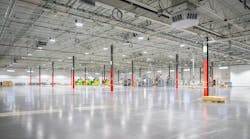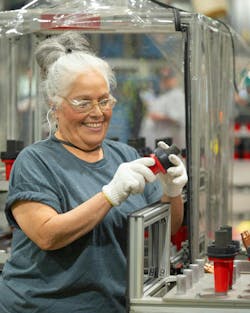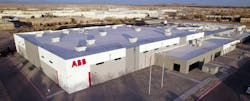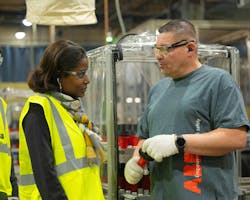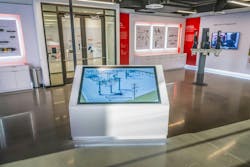The word on many people’s minds in the business press for at least the past year has been “reshoring.”
Through some policy or another, presidents have promised to bring manufacturing jobs back to the U.S. since deindustrialization hit in the 1970s and 1980s, when free-trade agreements resulted in labor intensive industries moving their manufacturing bases to developing countries.
They make these promises because it sounds good. Americans like to feel that this is a country that makes stuff. Offshoring much of U.S. manufacturing, however, was not done in a day. It took place across decades.
Reshoring, whatever you think about how or whether it should be done, will take time. Bringing factories back to the U.S. will be a long, involved process. In the meantime, the latest effort to spur it is causing some disruption.
Tariff policy is becoming increasingly complicated — and talked about. President Trump, who likes to say “tariff” is “the most beautiful word in the English language,” is making imposing duties on goods from around the planet a key part of his economic revitalization plan.
At the time of this writing, there are 10% blanket tariffs on almost everything the U.S. imports, which includes raw materials manufacturers use to make their products or expand their operations. There are especially high tariffs on China, and that nation has retaliated with steep duties of its own.
Rebuilding Supply Chains
Still, in some cases, there could be opportunities for manufacturers. One such area of need exists here in the power sector: We need transformers, switchgear, conductors, power poles, meters, sensors and dozens of other categories of goods, many of which need to be specifically tailored to the job for which they are needed.
Doug Houseman, Senior Managing Consultant with 1898 & Co., a unit of Burns & McDonnell, said just as they have been since about 2020, order lead times for needed goods are up, and the cost for a used transformer are up about 20% over the past year.
“There is a limit to used or remanufactured equipment at the very large size, and those supplies are being drawn down by industrial customers, Bitcoin and renewables. We may hit the wall on used equipment in the next two to three years,” Houseman said.
Some relief should show up, he said, in about 12-36 months as some of the promised manufacturing spending takes place and more workers are trained. Houseman said the workforce training will be a bottleneck for reshoring even more than the time it will take to build, expand or retrofit factories.
“Supply for what we make is tight, but adequate for pieces made in the US or Canada, the tariffs may impact what pieces that are not sourced here,” he said. “One of the fun things to think about are the railcars and semi-trailers to move the larger transformers to site, those can take 18 months to build and test.”
Houseman said Hitachi Energy got out in front of the issue by announcing and executing on a major transmission capacity expansion.
Long Wait Times Persist
Travis Edmonds, Vice President of Supply Chain, Transformers, North America, Hitachi Energy said lead times for key transformer types are 3-4 times longer than they were a few years ago.
In addition to changes in tariff policies and the accompanying economic turbulence that accompanied them, Edmonds said the tightening market is the result of multiple trends converging: accelerated energy transition goals, grid modernization efforts, transportation electrification and the rapid of energy demand in key markets like data centers.
“Our most critical suppliers have invested hundreds of millions alongside us as we have grown together,” Edmonds said. “We are investing heavily to expand capacity across all our North American manufacturing footprint. This includes the recent announcement of a $250 million global investment in our transformer insulation and components business, roughly 40% of which will be in the U.S.”
New Investments in Manufacturing
Most recently, on April 25 Hitachi Energy announced a $22.5 million investment to make dry-type transformers in southwest Virginia, and Edmonds said there is more to come.
Some other manufacturers of power grid supplies that have announced new supply chain investments:
In Albuquerque, N.M., a unit of ABB opened a 90,000 square foot, $40 million manufacturing facility to produce components used in grid hardening, undergrounding and wildfire mitigation applications. These include Elastimold cable accessories and Fisher Pierce circuit indicators.
ABB also spent tens of millions on new production facilities in Selmer, Tennessee, and Senatobia, Mississippi. These factories will produce components to serve electrical distribution equipment and circuit breakers for large-scale industrial and technology-driven facilities, including data centers, factories and high-rise residential and office spaces.
April 25, MGM Transformers and VanTran Transformers opened a new 30,000-square-foot advanced manufacturing facility in Waco, Texas. This facility will provide 700 jobs and $1 billion in annual transformer production capacity, the companies said in a joint release.
April 23, GE Vernova said it would invest $600 million in its U.S. factories in Clearwater, Fla. and Charleroi, Penn. These factories make high-voltage instrument transformers and high-voltage circuit breakers.
In South Carolina, Eaton spent $340 million on a new facility in Jonesville that will build three-phase transformers, which it will also continue to build in existing facilities in Wisconsin.
Schneider Electric is spending $700 million through 2027 on facilities in Tennessee, Massachusetts, Missouri, Ohio, Texas and North Carolina. These facilities will produce medium voltage products, build molded case and air circuit breakers, and produce switchgear and power distribution products.
Pennsylvania Transformer Technology (PTT) is spending $102.5 million in Raeford, North Carolina to expand its transformer manufacturing and create some 200 new jobs, according to an announcement from the North Carolina governor’s office.
Mitsubishi Electric Power Products Inc. plans to invest about $86 million to build a switchgear factory in Western Pennsylvania that, once at full capacity, is expected to be home to more than 200 workers.
TMC Transformers USA is spending more than $15.3 million over the next five years in a new manufacturing facility in Waynesboro, Georgia, creating at least 110 jobs, according to an announcement from that state’s governor.
Electric Research Manufacturing Cooperative Inc. (ERMCO) is expanding its transformer manufacturing capacity in Tennessee in a move that company says will create 400 jobs.
The leaders of steel manufacturer Cleveland-Cliffs Inc. said in July they convert part of a shuttered West Virginia plant into a distribution transformer manufacturing center. That project is valued at $150 million.
Critical Components and Raw Materials
Specially-milled steel is a critical component of making transformers and other power grid components. Cleveland-Cliffs is one of the last remaining outfits in North America that mills grain-oriented electrical steel (GOES), which is a critical component in transformer cores and laminations.
Edmonds said Hitachi Energy has seen its suppliers invest in new transformer component manufacturing. However, the availability of key raw materials remains a complex challenge.
“Without proactive upstream investment, these material shortages are likely to maintain long-term constraints on the industry. The raw materials themselves are much more abundant, but the equipment needed for follow on processing as well as available labor in their locations, are the bigger challenges,” Edmonds said.
The newly imposed tariffs from the Trump administration, he said, are viewed by Hitachi Energy as short-term adjustments, and should not cause any interruptions in longer-term planning.
“Our team is continually monitoring and assessing the tariffs imposed by the administration,” he said. “These tariffs represent short-term adjustments, common with any change in government leadership. We aim to stick to our long-term plans and adapt as necessary to meet our goals and the needs of our customers.”
In many industries, the U.S. remains the fastest growing market in the world. Hitachi Energy’s domestic production is used almost exclusively in the U.S. power grid with a small fraction shipped to Canada and Mexico.
“The tariffs could make it more expensive to build here and, in some cases, cheaper for our customers to source from outside of the U.S.,” he said. “Historically, U.S.-based operations may have been viewed as one component within a diversified global footprint. Today, however, the U.S. is emerging as a strategic priority.”
Planning Long Term
Supply chains, regulatory support, and end-market demand are driving a reassessment of the region’s value proposition, he said.
“That said, uncertainties around long-term policy and regulatory frameworks may still give pause. As a result, many companies are maintaining optionality while awaiting greater clarity and alignment between public and private stakeholders,” he said.
Another important factor is that even within favorable conditions for expanding manufacturing, a global supply chain and free trade are still necessary so the U.S. can access goods it cannot produce within its own borders. Some may take decades to catch up on production, and some much longer.
“Building local capacity is critical to strengthening supply chain resilience, but it doesn’t eliminate the need for a global supply chain to meet demand when it can’t be fully served from within the U.S.,” he said. “Most of the transformers we deliver into the US are built in American plants by American workers, using largely domestic materials. Still, we rely on global supply chains to provide surge capacity in response to rising demand.”
Building a truly scalable, cost-effective manufacturing base in North America will require continued collaboration across industry and government, as well as clear, supportive policy, he said.
Policy shifts and presidents come and go, at least from the point of view of a multinational manufacturer operating across a host of countries. However, the drivers are remaining steady: The U.S. needs power grid components because of the increased demand for renewable energy integration, electrification of homes and transportation, and the boom in data centers and the industries that require them.
“These trends are structural in nature. That said, fiscal constraints and political headwinds can affect the availability of funding for critical grid upgrades. This underscores the importance of coordinated action among utilities, manufacturers, and policymakers,” he said. “International examples, such as procurement guarantees in Canada, demonstrate how targeted policy measures can de-risk investment and maintain momentum in grid transformation.”
